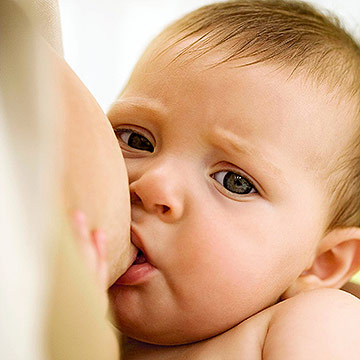
Latching Problems
Open up a book on breastfeeding, and you'll find photo upon photo of serene mothers happily nursing their babies. Unfortunately, many new nursing moms don't have it so easy. Some women face physical obstacles that take time, patience, and sometimes professional help to resolve. But rest assured, there are few troubles that can't be handled. Here are the most common nursing problems and how to solve them.
When Baby Can\’t Latch Properly
Your baby's "latch" refers to his ability to position your nipple in his mouth so that he can get the most milk with the least effort. There are a variety of issues that can affect baby's latch. One of the most common is the fact that your newborn may simply have trouble figuring out how to use your breast to get food, according to international board-certified lactation consultant Janaki Costello.
If this is the situation, she recommends looking for hunger cues, such as rooting, and feeding baby before he's crying with hunger. That way, he won't be as distracted when he's trying to latch. It's also important to be patient. "It takes some babies several tries before they can latch on correctly," she says.
Sometimes, latching problems occur because of improper positioning; baby may not be taking enough of the nipple into his mouth, or you both may be resting in less-than-ideal positions. Though it may seem counterintuitive, you may have to grip your baby firmly by the back of his head and cram as much of the nipple into his mouth as you can.
Then, look down at baby; if your entire nipple and areola aren't in his mouth, you'll need to readjust the latch. Nursing pillows or rolled-up blankets can help prop both of you into a more comfortable, effective position. Another sign that baby's latch is incorrect: When your baby is finished nursing, the tip of your nipple appears sharpened into a point or flattened like the head of a screwdriver.
In rare cases, your nipples may need a little help. "I could only get my son to latch on with three people helping me because I had flat nipples," says Sue Graves, of Stow, Massachusetts.
Women whose nipples don't protrude enough for the baby to latch have a number of options: breast shells, which fit over the nipple and apply gentle pressure to help it protrude; stretching exercises; or a breast pump, which can help pull the nipple out.
Cracked Nipples, Plugged Ducts
Cracked Nipples
This condition is pretty unsightly, "and one of the most painful things I've ever experienced in my life," says Heather Schuman, of Seattle.
"The primary cause of cracked nipples is an improper latch," says Sharon Mass, MD, the American College of Obstetricians and Gynecologists' representative to the U.S. breastfeeding committee.
To soothe sore nipples, she recommends using a pure lanolin-based breast cream that's safe for nursing babies, as well as soaking your nipples in clean, warm water.
To help adjust your baby's latch, you'll need to schedule a visit with a lactation consultant. She'll watch your baby feed and help you reposition her or give you exercises to do with her. "Cracked or bleeding nipples can heal remarkably fast once the latch is adjusted," says Costello.
If you're unable to breastfeed because of painful nipples, she advises using a breast pump until they're sufficiently healed.
Plugged Milk Ducts
Milk ducts are pipelines in your breasts that deliver milk to your nipples. Like all "plumbing," they can develop clogs, resulting in plugged ducts.
Two months after the birth of her son, Erin McKenna, of New York City, developed one of these clogs. "It happened in all different areas of the breast but most frequently in the milk ducts closest to my underarm," she says. Happily, Mother Nature has supplied us with ducts galore, so a few plugged ones won't interfere with milk production, but they are annoying and painful.
"Plugged ducts are a localized blockage of milk in the breast and feel like painful knots," says Dr. Mass. They can be caused by ineffective drainage of the breast, a blocked nipple pore, or even restrictive bras. She advises treating the area with moist, hot compresses. Gentle massage before and during feedings can also help, as can choosing a softer, looser bra without an underwire. However you decide to treat your duct trouble, be sure to keep nursing, as that will help keep your milk flowing freely.
Engorgement & Mastisis
Engorgement
Julie Vanneman, of Pittsburgh, had a textbook case of engorgement. "My breasts were rock-hard, enormous, and painful," she says. It usually happens when your milk first comes in or if you've gone too long between feedings. Luckily, it's easy to remedy. The most important step you can take is to pump or hand-express some milk.
"Latching onto an engorged breast can be difficult for a baby, so pumping or hand expressing just enough milk to soften the areola can help get the baby on," says Costello. Ultimately, the more you nurse, the less likely it is you'll get engorged in the future.
Dr. Mass advises frequent nursing, warm compresses before feeding, and cold compresses after to relieve pain. Costello recommends an old-fashioned pain reliever: cabbage leaves. Place a head of cabbage in your freezer. When you need a breast-shaped ice pack, peel off a leaf and place it on your breast for 15 to 20 minutes.
Mastitis
Two weeks after her baby was born, Katie Moody, of Oak Park, Illinois, had some serious breast pain. "One quarter of my right breast was very painful, red, and hot, and I had a 102-degree fever," she says.
She'd come down with mastitis, which can also include other flu-like symptoms, such as body aches, and is most common two to three weeks after giving birth, according to Dr. Mass. It can also happen during weaning.
The cause? "A bacterial infection, often due to a break in the skin, plugged milk ducts, or engorgement," Dr. Mass says. The first sign of it is usually breast pain, so contact your doctor if you have any symptoms. Mastitis requires antibiotic treatment and frequent hot compresses to help break down the blockage. It's also very important to continue breastfeeding, drink lots of fluids, and get as much rest as you can.
Thrush & Too Little Milk
Thrush
Thrush is a yeast infection on your breast. If you've ever had one in another area, you know how uncomfortable it can be.
"Between feedings, my nipples felt like they had a painful itchiness to them, almost like sunburn," says Ellen Rubin, of Pittsburgh, who developed the infection three weeks after her baby was born. Thrush can also cause stabbing, shooting pains and a red rash.
And chances are, if you have it on your breast, your baby has it in his mouth. Your doctor will treat both of you with an antifungal medication that you apply to your nipple and drop in your baby's mouth. You can continue nursing, but it's important that both of you get treated or you may wind up swapping the fungus back and forth.
Not Enough Milk
Women frequently feel that their babies are not getting enough milk, according to Lawrence Gartner, MD, chair of the executive committee of the American Academy of Pediatrics' (AAP) section on breastfeeding. Fortunately, the fear of low milk supply is largely unfounded.
"The key is information and support," says Dr. Gartner. "It's important to know how breastfeeding works," he says. Breast milk is all about supply and demand; in the beginning, a baby may need to nurse every two hours for the mother to build up a good milk supply. He advises approximately 10 feedings per day for the first few weeks, then approximately eight feedings per day for the next three months; time-consuming, but necessary.
The rare woman who isn't producing enough milk is clued in if her infant isn't gaining sufficiently. If you're one of them, your pediatrician will monitor your baby carefully and may suggest formula supplementation while you increase your milk supply. Increasing the frequency of feeding, as well as pumping in between feedings, can step up your supply. Your diet plays a big role in how much milk you produce, too; drink as much water as you can, and continue to take in about 300 to 500 extra calories a day to provide your body with the fuel it needs to make milk for your baby.
The AAP recommends that mothers exclusively nurse their babies for the first six months of life. And with the right kind of information and support, just about any mother who wants to breastfeed can do exactly that.
Help for Nursing Moms
For more information on breastfeeding:
Amy Sirot is a writer in Brooklyn, New York.
Originally published in American Baby magazine, December 2004.
All content here, including advice from doctors and other health professionals, should be considered as opinion only. Always seek the direct advice of your own doctor in connection with any questions or issues you may have regarding your own health or the health of others.
American Baby

